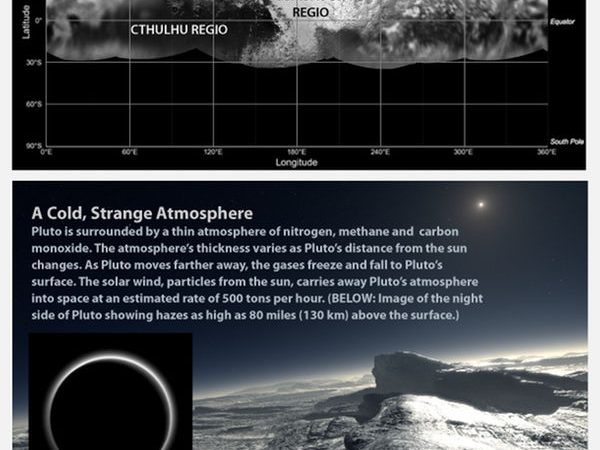Pluto is a very strange world. With satellites like Charon and New Horizons, we have learned a little more about it.
Orbiting in the dim and frozen outlands of the solar system, Pluto remained undiscovered until 1930. An early guess at Pluto’s size had it about the same as Earth’s. Now Pluto is known to be a dwarf planet only 1,473 miles (2,370 kilometers) in diameter.
Pluto has a large, heart-shaped feature scientists have informally named Tombaugh Regio after Pluto’s discoverer, Clyde Tombaugh.
A closeup of the Tombaugh Regio “Heart” feature reveals a craterless plain, called by scientists Sputnik Planum after the first space satellite. Scientists estimate the plain, which is composed of frozen carbon monoxide, is no more than 100 million years old. The plain appears to be divided into many irregular polygons with narrow troughs between them. Also visible are mounds and pits.
A high-resolution photo of the terrain south of Tombaugh Regio reveals a young surface featuring mountains of water ice up to 11,000 feet (3,500 meters) high. The lack of impact craters suggests that Pluto has active internal processes, despite the fact that there is no nearby gas giant planet to provide tidal energy to power geological activity.
Pluto and its largest satellite Charon are tidally locked to one another. That is, each presents the same face to the other, and neither body moves in the other’s sky. Similarly, our moon is tidally locked to the Earth and always presents its “near side” face to us.
Pluto and Charon both orbit around a point called the barycenter. In the only known such case in the solar system, the Pluto-Charon barycenter lies outside the body of either object. However, the International Astronomical Union has stopped short of classifying the system as a binary planet, instead calling Charon a satellite of Pluto.
Charon’s north pole features a large dark region nicknamed Mordor, composed of a thin deposit of dark material. A canyon along the right edge of the photo could be 4 to 6 miles (7 to 9 km) deep. A surprisingly smooth plain with few impact craters indicates a young surface. A swath of cliffs and troughs 600 miles (1,000 km) across indicates widespread fracturing of Charon’s crust.
As New Horizons approached Pluto, the probe’s photographs revealed a surface that is complex and varied, with many bright patches (including huge, heart-shaped Tombaugh Regio) and dark features, including a whale-shaped dark patch mission scientists have dubbed Cthulhu Regio. In addition, Pluto has a polar cap composed of frozen nitrogen and methane.
Pluto is surrounded by a thin atmosphere of nitrogen, methane and carbon monoxide. The atmosphere’s thickness varies as Pluto’s distance from the sun changes. As Pluto moves farther away, the gases freeze and fall to Pluto’s surface. The solar wind, particles from the sun, carries away Pluto’s atmosphere into space at an estimated rate of 500 tons per hour.
Pluto’s path around the sun is off-center and and highly inclined compared with the major planets. This means that some of the time Pluto is closer to the sun than giant planet Neptune. At its farthest, Pluto is 4.5 billion miles (7.3 billion kilometers) from the sun. Pluto takes 248 Earth years to orbit the sun.
Source: Space.com

































Leave a Comment
You must be logged in to post a comment.